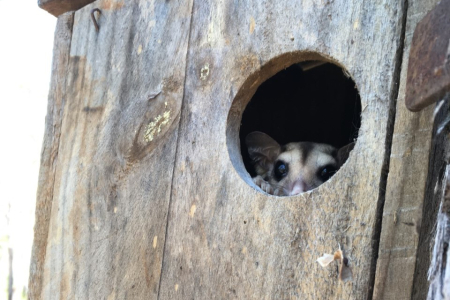Tree hidey-holes key to helping slow declines of small mammals
A decline of natural tree hollows is forcing arboreal mammal numbers to fall, according to a new study exploring why these species are disappearing in Northern Australia.
The study led by Charles Darwin University’s (CDU) Research Institute for the Environment and Livelihoods (RIEL) investigated whether the number of tree hollows in Northern Australian tropical savanna are contributing to the decline of arboreal mammals, or animals that live in trees.
Researchers surveyed 187 nestboxes placed across the Cobourg Peninsula within Garig Gunak Barlu National Park during the three-year study period. They found that in total 67 per cent of nestboxes were used by mammals at least once.
Of the 119 nestboxes monitored by camera 82 per cent were used by mammals: 56 per cent by the brush-tailed rabbit-rat, 44 per cent by the savanna glider, 41 per cent by the black-footed tree-rat, 15 per cent by the fawn antechinus, and four per cent by the northern brushtail possum.
Lead author and RIEL Adjunct Research Associate Dr Leigh-Ann Woolley, who is also the Northern Australia Biocultural Conservation Manager for WWF-Australia, said the high number of mammals using the nestboxes was unexpected.
“We were sceptical that mammals would use the nestboxes we deployed at all, never mind that their nestbox use would be strongly associated with tree hollow density at a site,” Dr Woolley said.
“This showed that these declining arboreal mammals were searching for and using new dens where natural hollows were reduced at a local site.
“Amongst the multitude of threats interacting to cause the decline of these species, such as inappropriate fire, introduced ungulates, and feral predators, habitat quality should not be disregarded when managing threats to improve outcomes for these mammals.”
Arboreal mammals play a crucial role in savanna ecosystems by dispersing seeds, pollinating plants, and have adapted to take advantage of unique seasonal savanna features such as frequent fires, flowering and fruiting plants, grass seeds, insects, eucalyptus sap, amongst many others.
Dr Woolley said to slow declines and stop extinctions of hollow-using animals in northern Australia, protecting large savanna eucalypts as ecosystem assets would be critical.
“Good quality habitat with ample tree hollows for denning and nesting, as well as high quality and abundant food sources, will buffer against other serious threats to these animals,” she said.
“For example, arboreal mammals don’t need to spend as much time on the ground travelling between trees if tree density is higher. Less time on the ground means they are less vulnerable to predation by feral cats.
“Short-term strategies to support arboreal mammals include halting land clearing and protecting large, hollow-bearing savanna eucalypts. Longer-term strategies to optimise habitat include fire regimes dominated by cooler, less frequent fires to ensure large trees are retained, tree hollow densities are increased, and food resources such as fruiting shrubs are enhanced.”
The study was conducted alongside the Department of Biodiversity, Conservation and Attractions in Western Australia, the Department of Environment, Parks and Water Security in the Northern Territory, and the University of KwaZulu-Natal in South Africa.
Nestbox use indicates declining arboreal mammals in an Australian savanna may be limited by tree hollow availability was published in the journal Forest Ecology and Management.
Related Articles

Is this AI or a journalist? Research reveals stylistic differences in news articles
News articles produced by Artificial Intelligence (AI) do not have the same creative flair as stories written by human journalists, according to research into the stylistic differences between the storytellers.
Read more about Is this AI or a journalist? Research reveals stylistic differences in news articles
Inspired NT just got Radicle
From Inspired NT to CDU Radicle Centre the Charles Darwin University (CDU) Faculty of Science and Technology Team is working on more ways to engage with young Territorians.
Read more about Inspired NT just got Radicle
NT to become Australia’s brightest spark with CDU’s new Energy and Resources appointment
After a career crossing continents and fields, Professor Maurizio Cirrincione has landed in the Top End of Australia to take the helm of Charles Darwin University’s (CDU) Energy and Resources Institute (ERI).
Read more about NT to become Australia’s brightest spark with CDU’s new Energy and Resources appointment

